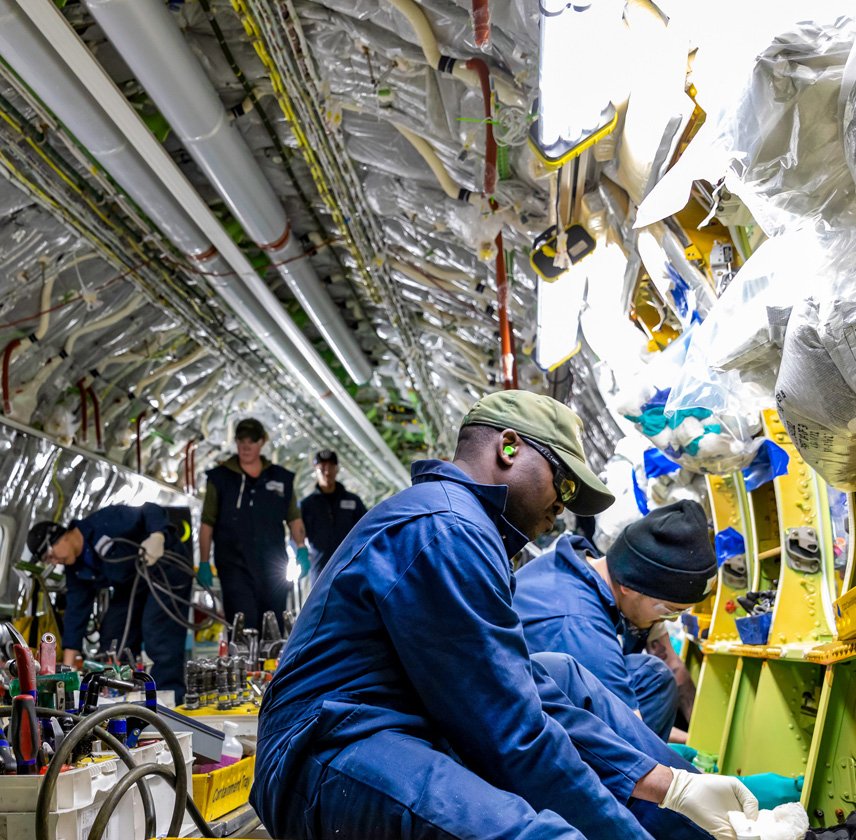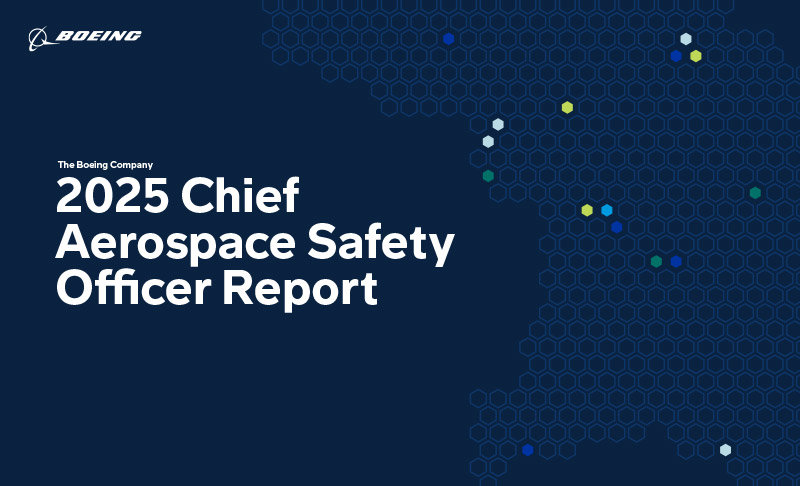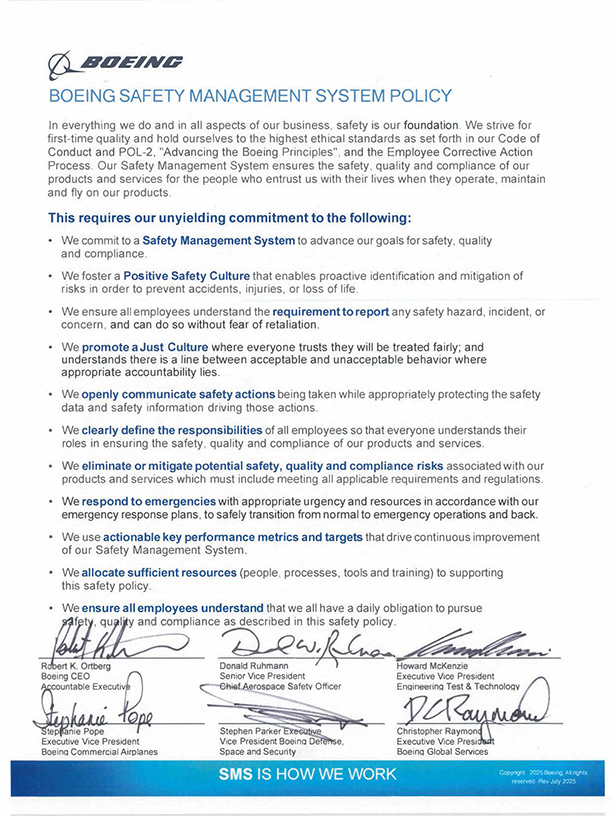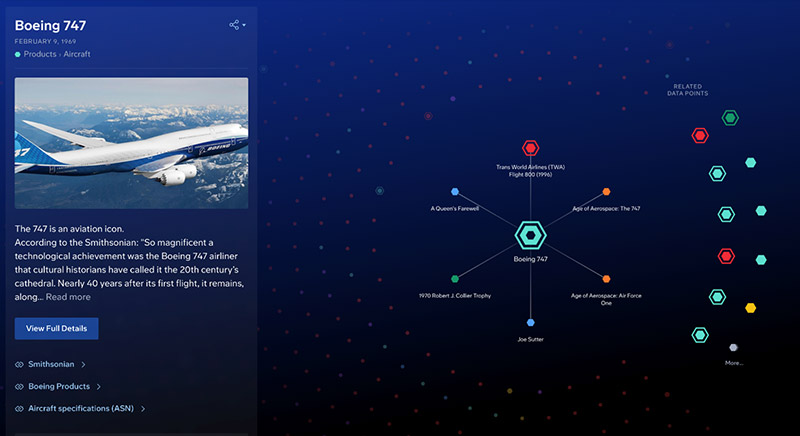This annual report summarizes our progress in driving improvements in the safety of our products and services, and our contributions to the industry’s shared goal of safety. The report covers the variety of ways we at Boeing are learning – and applying that knowledge to drive improvements that protect human life. We do this by focusing on our safety culture, practices and collaborations with customers and industry around the world.
What's new: highlights from advancements made in the last 12 months
- Safety Culture
- Safety Practices
- Safety Collaborations
Strengthening our safety culture
Enhanced and encouraged use of Speak Up, Boeing’s confidential and anonymous reporting channel for product and services safety, quality and compliance concerns. The yearly volume of reports increased by 220%.
Deployed required safety and quality training to nearly 160,000 employees, focused on their role in identifying and reporting potential product hazards.
Published on Boeing’s external website an immersive timeline of events in history that shows how Boeing and the aerospace industry have applied learnings from accidents, technological achievements and people – to further advance aviation safety.
Doubled the number of Boeing teammates in the SMS Champions Program to more than 1,000. The program enables participants to gain a greater understanding of SMS and advocate for its use as they go about their work.
Improving our safety practices
Developed and submitted to the U.S. Federal Aviation Administration (FAA) a comprehensive set of actions to address recommendations made in an expert panel’s safety review.
Implemented more than 20 Design Build Safety reviews, in which teams apply the SMS Safety Risk Management practice to ensure engineering requirements are being translated into production of defect-free airplanes.
Supported the continued improvement in the percentage of FAA-delegated Organization Designation Authorization (ODA) unit members who, in a 2024 survey, reported being able to perform their delegated duties free from interference.
Expanded the sources and systems monitored for safety data throughout the product lifecycle, and widened the application of machine learning to augment Boeing teams in proactively identifying and addressing potential hazards.
Implemented no-notification product safety and quality audits at five Commercial Airplanes sites, in addition to regularly scheduled audits. These audits evaluate product conformance to specified technical requirements.
Collaborating for a safer industry
Engaged more than 300 airline operators in developing and implementing comprehensive, integrated solutions that further strengthen operational safety.
Convened the third annual Boeing Aviation Safety Conference, bringing together nearly 300 top experts from across the aviation industry, including representatives from 90 carriers, pilot associations and regulatory agencies, to exchange knowledge, best practices and insights on industry challenges.
Launched a series of new multimedia task aids to help operators’ maintenance crews ensure the safety of the airplanes they work on.
Boeing Safety Management System
Boeing’s Safety Management System
Recognized worldwide as an industry best practice, SMS is an integrating framework for managing safety risks. Boeing’s SMS collects and monitors data to identify and reduce product safety risks. It relies on all those involved in the design, build, support and operation of Boeing products and services to speak up when they see safety risks.
Speak Up: Fostering Transparency and Openness
Product safety depends on a culture that is rooted in transparency, accountability, and every person feeling safe and empowered to speak up when they have a concern or make a mistake affecting product safety. This reporting culture is at the heart of Boeing’s Safety Management System. In 2019 Boeing established a confidential reporting channel called Speak Up for employees to voice their concerns about product quality and safety and offer ideas for how to improve.
Boeing Safety Management System Policy
In everything we do and in all aspects of our business, safety is our foundation. We strive for first-time quality and hold ourselves to the highest ethical standards as set forth in our Code of Conduct and company policies. That commitment begins at the highest levels of the company.
Boeing Commercial Airplanes Safety & Quality plan
Further implementing Boeing’s Safety Management System is a part of Boeing’s Safety and Quality plan.
Updates on Boeing’s actions to strengthen safety and quality.
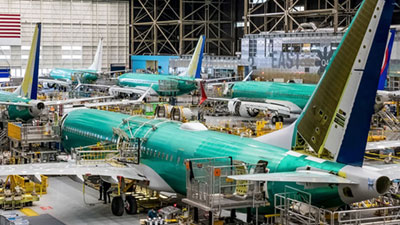
Safety Experience at Boeing
Safety Promotion is a key part of Boeing’s Safety Management System because it fosters a culture where safety remains a shared value and priority. To strengthen this commitment, Boeing developed an immersive, interactive tool that shows pivotal moments in history that have led to advancements in aerospace safety. Originally developed for Boeing employees, the Boeing Safety Experience Timeline is now available to the public and serves as an extensive learning and research tool that spans from the Wright Brothers’ first flight to modern-day space exploration.
Products
Safety is at the core of who we are and what we do. Boeing leverages its legacy of innovation and existing safety assurance practices to ensure product safety.
Safety by Design
Safety is the primary consideration when Boeing engineers design an airplane. In addition to meeting regulatory requirements before certification, each airplane model must meet Boeing’s time-proven design standards. Often these standards are more stringent than regulatory requirements.
Testing
Boeing airplanes are rigorously tested to ensure they meet or exceed design standards and certification requirements.
There are many kinds of tests. For example, structural strength is ensured by static and fatigue tests. Static tests apply maximum loads or pressure to validate the airplane’s ability to carry loads far greater than would be encountered under normal operational conditions.
Continuous Monitoring
Boeing continually monitors the performance of airplanes worldwide to identify opportunities to improve safety.
In-service events are analyzed through a formal, disciplined, safety process involving Boeing experts from a variety of technical disciplines, as well as senior and executive leaders.
Human Factors
Apart from airplane equipment and technology, Boeing studies and applies human factors engineering lessons to the design of commercial airplanes.
Boeing human factors experts gather information about human abilities, limitations and other characteristics and apply the data to tools, machines, systems and processes.
Working Together to Strengthen Aerospace Safety
Aviation safety depends on the collaboration of industry organizations and governments. Boeing works together with these stakeholders and airline operators to continuously advance safety in all aspects of the global air transportation system.
An example of this collaboration is the Commercial Aviation Safety Team (CAST), which comprises representatives from airlines, manufacturers, labor and government.
Accident Prevention and Investigation
Although the industry’s safety efforts focus on preventing accidents from occurring in the first place, a great deal of effort goes into investigating accidents to ensure they do not reoccur. Boeing is committed to its role in helping all stakeholders understand the data associated with airplane accidents.
Read the Statistical Summary of Commercial Jet Airplane Accidents.
Employee Safety
An essential part of product safety includes ensuring the safety of those who design, build and support our products and services. Boeing’s workplace safety initiative Go4Zero strives for a goal of zero injuries, guided by the belief that every injury is preventable. The Go4Zero Safety Guiding Principles provide a framework to achieving this goal so every person who works at or visits a Boeing site leaves as safe and healthy as when they arrived.

Safety Guiding Principles
Our Safety Guiding Principles are the foundation of safety at Boeing. Each principle addresses a specific aspect of a healthy safety culture. Built around the concepts of safe decision-making and a commitment to protecting each other, the Guiding Principles guide the Go for Zero—One Day at a Time effort across the company, from frontline employee to CEO.
- We value human life and well-being above all else and take action accordingly.
- All incidents, injuries and workplace illnesses are preventable.
- We are personally accountable for our own and collectively responsible for each other’s safety.
- By committing to safety first, we advance our goals for quality, cost and schedule.
Celebrating 10 years of Go4Zero
More than ten years ago, Go4Zero was introduced to help increase safety in our workplace. Boeing has made impressive safety strides since 2013, but we know our safety journey is never done.
26%
decrease in serious injuries
(since 2015)
62%
decrease in recordable injuries
(since 2013)
71%
decrease in lost workday cases
(since 2013)
71%
decrease in ergonomic injuries
(since 2013)
Sustainability
We are focused on innovating and operating to make the world better for future generations through environmental stewardship, social progress and values-driven governance.
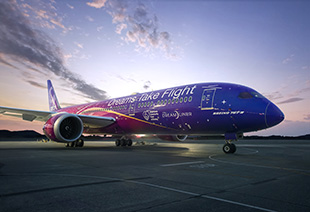
Safety is personal for Boeing teammates
The Boeing team is dedicated to ensuring every person who flies on, uses, operates, designs, builds or services Boeing products gets home safely. Click below to hear their stories.
- Khatwa
- Wolkiewicz
- Lowe
- Plumleigh
- Kang
- Hall
- Tinnesand
- Kros
- Ma

